
| Scuba Diving Pictures Main Page |
|
|
The following images are thumbnails. If you click on them a larger image will open up and the picture will take up most of your screen. Again these are medium qualifty jpegs. Higher quality images can be purchased directly from me via paypal using my email address tjfidler@telus.net And many of these photos can be found for sale on Cafepress through the Calendar link and Photo CD link. As well some of these can be found as posters via Cafepress, and some of these ocean life photographs are available as widescreen backgrounds via the widescreen link immediately below some of the photographs.
A few people have already asked me about "What is that pink stuff on the rocks in some of the pictures?" Well, they're usually Pink Rock Crust (aka Encrusting Coralline Algae) or in some cases might even be Encrusting Hydrocorals. They're eaten by a variety of animals - apparently as a good source of calcium.
Links to the various groups of organisms:
Cephalopods, Crustaceans, Fish, Mollusks, Nudibranchs, Sea Anemones, Sea Cucumbers & Echinoderms, Sponges, Tunicates, Worms, Miscellaneous
Crustaceans
 |
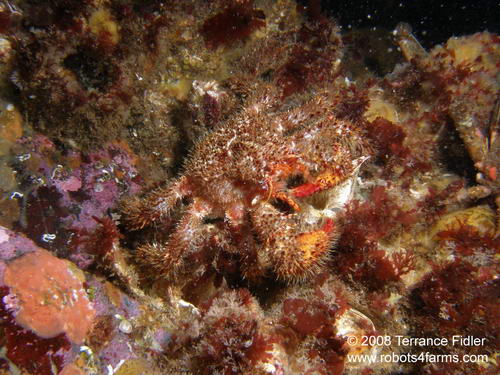 |
| Bering Hermit Crab beside some Orange Cup Corals, and Orange
Social Ascidians. Note that some of the orange tunicates are yellow for some reason. Will have to ask one of the more knowledgeable people I know as to why this might be. Orange Cup corals ~ 1.5 inches [3.75 cm] across. (October 10, 2008) |
Hairy Spined Crab this is the
first one I've ever seen. Out of over 250 dives. ~ 8 inches [20 cm] wide with the legs included. It did sit still for about 4 pictures. So, it was not afraid of me. (October 10, 2008) |
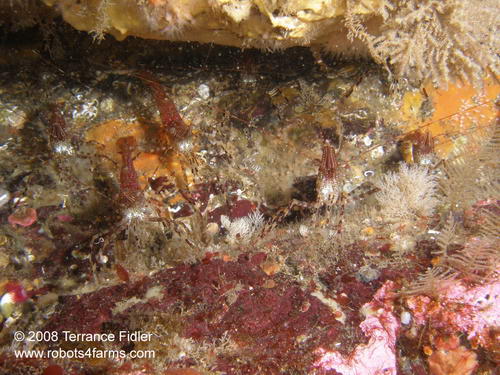 |
 |
| A few Coonstriped Shrimp ~ 3
inches [7.5 cm] along the main body. (October 10, 2008) |
Decorator Crab ~ 4 inches [10
cm] wide with legs. With a few Giant Acorn Barnacles around it. (October 10, 2008) |
 |
 |
| Moss Crab ~ 4 inches [10 cm]
long. Surrounded by several young Short Plumose Anemones. Depending on how much sponge they have living on them, it can be difficult to tell whether the animal is a moss or just a normal decorator crab. (October 10, 2008) |
Puget Sound King Crab ~ 20
inches [50 cm] wide with the legs. This was the only adult I saw on the trip, but othe divers said they saw more. (October 10, 2008) |
 |
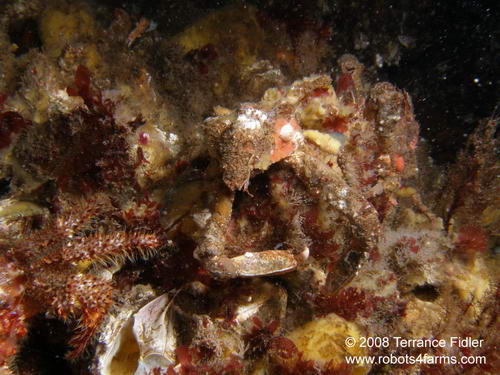 |
| Puget Sound King Crab ~ 5 inches
[12.5 cm] across. This was actually only a few feet from the adult shown in the image to the top right of this one. (October 10, 2008) |
Sharp Nosed Crab ~ 4 inches [10
cm] across the main shell. Note the legs of the Hairy Spined Crab are also in this picture. Just to the left of the Sharp Nosed Crab. (October 10, 2008) |
 |
|
| Shrimp of some kind. ~ 2 inches
[5 cm] long. Note the chiton to the right of it. (October 10, 2008) |
Back to top.
Fish
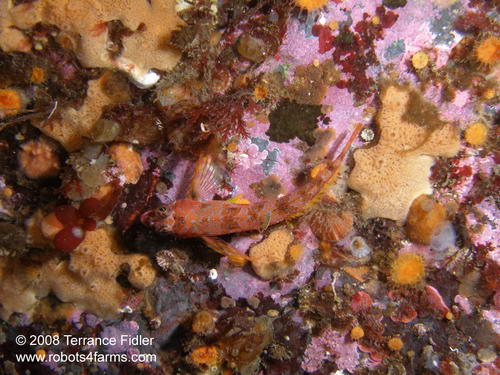 |
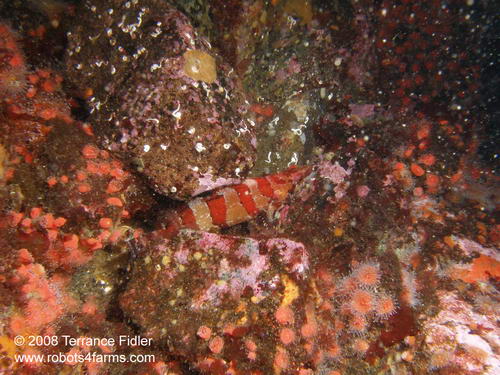 |
| Longfin Sculpin [a fish] ~ 6 inches [15 cm] long. These are
usually a hard fish to take a picture of. And this one in fact ran away after I took this single photograph. (October 10, 2008) |
Painted Greenling [a fish] ~ 10
inches [25 cm] long. Not a very good image but none of the ones encountered would stay still long enough for a better photograph. (October 10, 2008) |
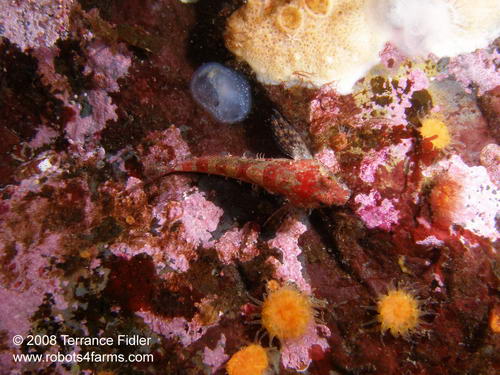 |
![Click on here for a larger image Scalyhead Sculpin [a fish] and some hermit crabs - Copper Cliffs Campbell River - scuba diving site vancouver island british columbia canada](scubadivingpictures_files/coppercliffs_cr_files/99_jms_ScalyheadSculpinPlusHermitCrabs_90p_PA060236_tmb.jpg) |
| Scalyhead Sculpin ~ 4 inches [10 cm] long. (October 10, 2008) | Scalyhead Sculpin ~ 4 inches
[10 cm] long. Plus some small hermit crabs. (October 10, 2008) |
Back to top.
Mollusks
 |
 |
| Abalone ~ 8 inches [20 cm] long. (October 10, 2008) | Gumboot Chiton ~ 6 inches [15 cm] long. (October 10, 2008) |
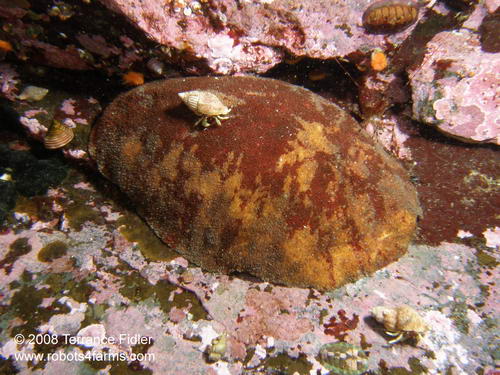 |
 |
| Gumboot Chiton ~ 12 inches [30
cm] long. And a couple of Hermit Crabs and a Coonstriped Shrimp. Plus a few other animals. (October 10, 2008) |
Rock Scallop ~ 12 inches [30
cm] across. And a moss crab sitting on its top right. (October 10, 2008) |
|
|
Nudibranchs [or Sea Slugs] & Snails
 |
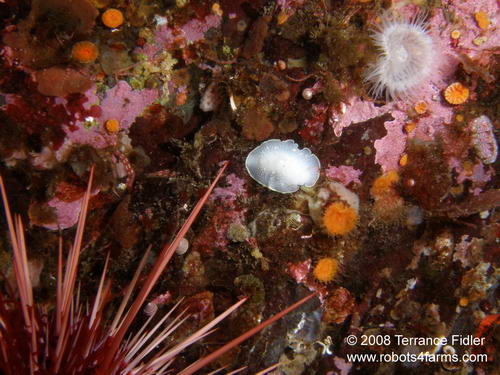 |
| Cockerells Dorid [Laila cockerelli] ~ 2 inches [5 cm] long.
This is only the 2nd
I've ever seen, and my best photograph of one. (October 10, 2008) |
Dorid of some kind. ~ 2 inches
[5 cm] wide. The spines at the lower left are from a Red Sea Urchin. If you look closely you may see the arms of Daisy Brittle Stars. (October 10, 2008) |
 |
 |
| Leopard Dorid ~ 4 inches [10 cm]
long. And beside a large Chiton. (October 10, 2008) |
Whitelined Dirona [aka Frosted
Nudibranch] ~ 4 inches [10 cm] long. (October 10, 2008) |
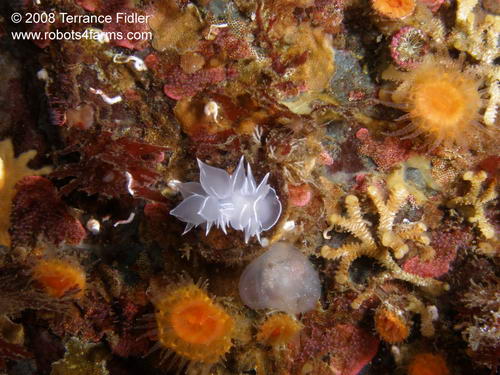 |
|
| Whitelined Dirona ~ 2 inches [5 cm] long. (October 10, 2008) |
Back to top.
Sea Anemones ( Cnidarians )
 |
 |
| Giant Plumose Anemones ~ 2 feet [60 cm] long. There were a
few of them closer to the surface at the bottom of the Kelp beds. Deeper down the life was dominated by Orange Cup Corals and Strawberry Anemones. (October 10, 2008) |
Strawberry Anemones ~ each about
1 inche [2.5 cm] in diameter. Not that common on the wall itself, but certainly more common near its base, and the bottom. (October 10, 2008) |
 |
 |
| White Soft Corals ~ 1.5 inches
[3.75 cm] hanging from the ceiling of this crevice. And a small sculpin [a fish] sitting in front of what appears to be some sort of colonial tunicates forming the off white mass. (October 10, 2008) |
Zoanthids ~ 1.5 inches [3.75 cm]
in diameter. Hanging on the wall and some Pink Encrusting Algae nearby. (October 10, 2008) |
Back to top.
Sea Cucumbers & Starfish ( Echinoderms )
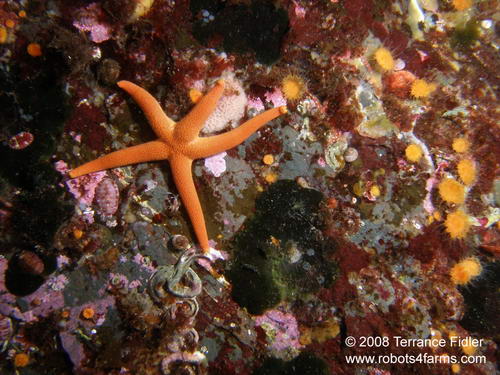 |
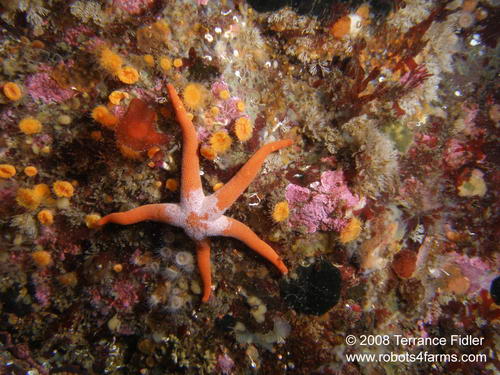 |
| Blood Star ~ 8 inches [20 cm] across. (October 10, 2008) | Blood Star ~ 10 inches [25 cm] across. (October 10, 2008) |
 |
 |
| Creeping Petal Sea Cucumber ~ 4
inches [10 cm] long to the base. This one is retracting itself into its base to protect itself from me. Otherwise they normally look like minature red Orange Sea Cucumbers. (October 10, 2008) |
Daisy Brittle Star ~ 4 inches
[10 cm] across. Normally you only see their arms out as they hide behind a rock as they try to capture particles of food with their arms. (October 10, 2008) |
 |
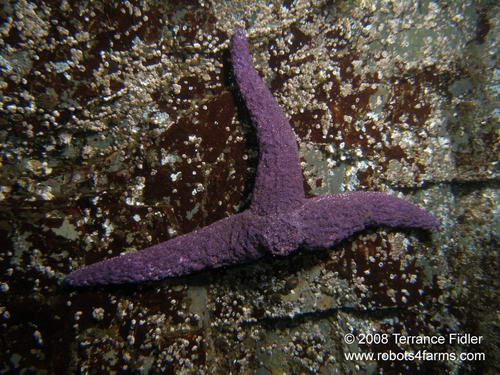 |
| Painted Starfish ~ 12 inches [30
cm] across. One of the most common starfish in the ocean here in British Columbia. (October 10, 2008) |
Purple Starfish ~ 14 inches [35
cm] wide. I believe it only has three arms because a Puget Sound King Crab may have eaten the other two arms. I've been told about this, but then maybe some other animal did this. (October 10, 2008) |
 |
 |
| Red Sea Urchin ~ 14 inches [35 cm] across the spines. (October 10, 2008) | Red, or may Purple, Sea Urchin ~
4 inches [10 cm] across the spines. (October 10, 2008) |
 |
![Scalyhead Sculpin ~ 4 inches [10 cm] long. Sunflower Starfish](scubadivingpictures_files/coppercliffs_cr_files/99_jms_SunflowerStar_90p_PA060116_tmb.jpg) |
| Red Sea Urchin ~ 2 inches [5 cm] across the spines. (October 10, 2008) | Sunflower Star[fish] ~ 14 inches
[35 cm] across. Based on the size this one is quite young. As they are normall 3 feet [1 m] across as adults. (October 10, 2008) Note that some of its arms are much shorter than the others. Probably regrowing after being bitten off by something. Possibly by Puget Sound King Crabs. |
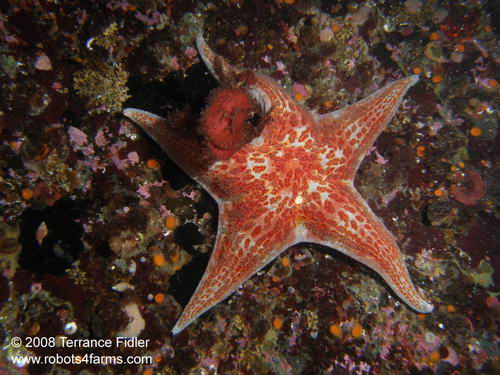 |
|
| Leather Star ~ 10 inches [25 cm]
across. It appears to be moving up against the tunicate to the top-left of it. (October 10, 2008) |
Back to top.
Tunicates
 |
 |
| Orange Social Ascidians
[tunicates] ~ 1/2 inch [1.25 cm] in diameter. And a few Orange Cup Corals. I'm still looking into why some of the tunicates are yellow. (October 10, 2008) |
Transparent Tunicates ~ 1.5 inches [3.75 cm]. (October 10, 2008) |
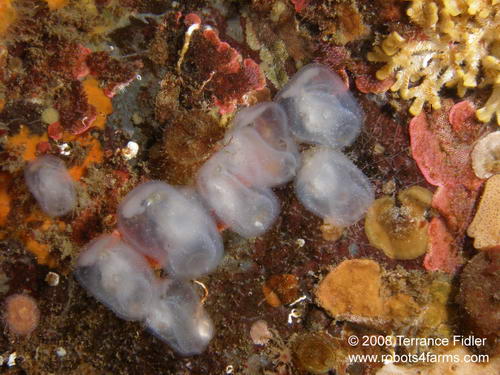 |
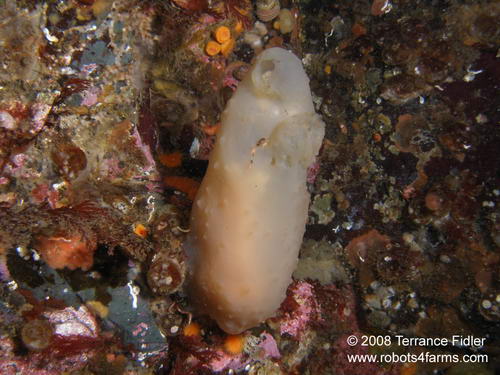 |
| Transparent Tunicates ~ 1.5
inches [3.75 cm] Note that there are also some Disc- Top Tunicates here as well. The ones with the brown tops. (October 10, 2008) |
Glassy Tunicate ~ 6 inches [15 cm] tall. (October 10, 2008) |
Back to top.
If you want to locate this site on a map, or print out a map, you can user either:
Google Maps: Best to talk to one of the local dive charters for directions.
Or
MapQuest: Best to talk to one of the local dive charters for directions.
